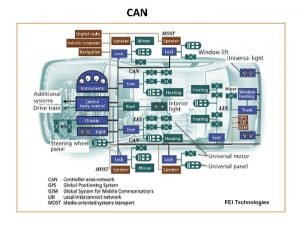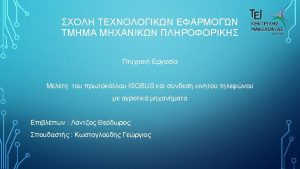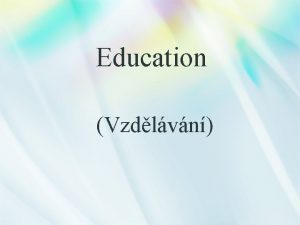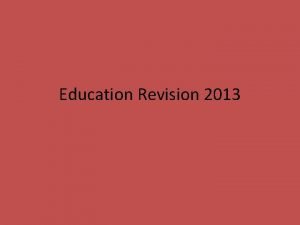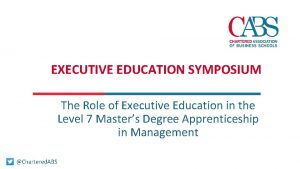What Can Education Do The Role of Education





















- Slides: 21

What Can Education Do? The Role of Education and Training in Reducing Youth Unemployment in Indonesia Pedro Cerdan-Infantes Economist, Education Unit World Bank Jakarta March 31 st, 2011

Three General Objectives Improve cognitive skills for youth Ensure every young person has a good skill base Reduce skills mismatch Supply what the market demands Skills upgrading Provide better opportunities for training

Indonesian youth are more educated than ever… 120. 0 107. 7 106. 6 110. 4 100. 0 80. 0 60. 0 82. 1 77. 6 81. 1 62. 4 50. 2 55. 2 GER SMP GER SMU GER Higher 40. 0 20. 0 GER SD 14. 6 11. 1 10. 3 0. 0 2001 2002 Source: Susenas, various years 2003 2005 2006 2007 2008 2009

…but many students still drop out before SMU Source: World Bank calculations, Susenas 2009

For those who stay in school, learning is low… … but generally improving Math Score Reading Score 600 500 400 2003 300 2006 2009 200 100 0 0 Indonesia Brazil Mexico Thailand Korea Indonesia Source: OECD, PISA (2009) Brazil Mexico Thailand Korea

Three General Objectives and Policy Options Improve cognitive skills for youth Improve transition between levels: • Targeted scholarships • Perception of returns Improve learning: • Early childhood education • Quality of teachers • Inequality in quality of education • BOS and school based management Reduce skills mismatch Skills upgrading

Three Types of Skills Mismatches 1. Level of skills (i. e. too many university graduates? ) 2. Fields of study (i. e. too many economists? ) 3. Skills within fields of study (i. e. too many bad technicians? )

Skill level seems appropriate, the demand for skills is strong Rates of return Earnings differentials 18. 0% 140. 0% 16. 0% 120. 0% 100. 0% 14. 0% 80. 0% 12. 0% 60. 0% 10. 0% 40. 0% 8. 0% 20. 0% 6. 0% 2001 2002 2003 2004 2005 2006 2007 marginal rate of return junior secondary marginal rate of return senior secondary marginal rate of return tertiary Source: SAKERNAS (employed for wages), * Minimum wage increase of 10%+ in 2008 2009 0. 0% 2001 2002 SMP/primary 2003 2004 2005 SMA(K)/primary 2006 2007 2008 2009 Tertiary/primary

But skilled workers have a harder time finding a job Source: SAKERNAS 2009 (employed for wages)

Field mismatches at the tertiary level exist, but are not huge… Tertiary Enrollment by Major Average Wage by Major 2009 (20 -29 years old) Economic & Business Technic, Technology, Computer & Mathematic Teacher/Teaching Law Health 0% 10% Source: Mo. NE (2009) 20% 30% 40% 0 500, 000 1, 500, 000 Source: Sakernas (2009) 2, 000

… somewhat larger in the long run Source: World Bank calculations using Sakernas (2009)

Tertiary mismatches seem to be declining, and they are not necessarily bad Source: Alisjahbana, 2008, using Sakernas

At secondary level, vocational skills are in demand: Employers value job-specific training Most valuable asset of employees according to employers Source: Indonesia Skills Survey 2008, World Bank (2010)

The quality of the skills of graduates is a concern Quality of recently hired senior secondary graduates, according to employers Perception of main weaknesses according to recent graduates 100 35. 0 90 30. 0 80 70 Very Good 60 Fair 20. 0 15. 0 50 Poor 40 10. 0 5. 0 30 SMK General (SMA) Source: Indonesia Skills Survey 2008, World Bank (2010) Vocational (SMK) Relevance SMA Curriculum Average Senior Secondary Facilities 10 0. 0 Quality of learning/teaching Very Poor 20 0 25. 0

And the types of skills provided need to be reassessed… Types of skills identified as “very important” and “gaps” by employers 0. 6 Methods for assessing quality of potential employees 0. 8 0. 7 0. 5 0. 6 0. 4 0. 5 0. 3 0. 4 0. 3 0. 2 0. 1 0 Basic skills Thinking skills Behavioral skills Identifies as "very important" Computer Skills English Skills 0 The degree, transcrpits or institution attended Identifies as "skill gap in staff" Source: Indonesia Skills Survey 2008, World Bank (2010) Recommendations from employer Services Probation Manufacturing

Three General Objectives and Policy Options Improve cognitive skills for youth Improve transition between levels: • Targeted scholarships • Perception of returns Improve learning: • Early childhood education • Quality of teachers • Inequality in quality of education • BOS and school based management Reduce skills mismatch Improve SMK: • Skill mix • Expand successful models • Increase on-the-job experience (3+1) Labor market information • Malaysia graduate tracer • Labor Market Observatory (Colombia, Chile) Responsiveness of higher ed: • Autonomy • Flexibility Skills upgrading

Skills for what? Share of graduates continuing to tertiary education % continue to tertiary 40. 0% 35. 0% 30. 0% 25. 0% 20. 0% SMA 15. 0% SMK 10. 0% 5. 0% 0. 0% 28 27 26 25 age Source: Indonesia Family Life Survey 4 (2007 -08). 24 23 22

The ingredients for a functioning market for skills upgrading exist Large potential demand • Drop-outs (about 50%) • SMA/SMK graduates with inadequate skills (about 35%) • Diploma with need for specific skills (? ) • Laid-off workers with outdated skills (? ) Limited current supply • Private providers (LKP, Mo. NE) • Public Providers (BLK) • Private providers (Mo. MT) Potential expanded supply • Polytechnics / SMK • Firms (on-the job) • Firm-managed

But putting it together effectively is the difficult part § A model that works in developing countries: “Jovenes” (Latin America) ▫ ▫ ▫ Demand side subsidies Private and public provision competing for demand Autonomy for public provision Strong accreditation systems On-the job training component paid by the program § But can it be adapted to the Indonesian context? ▫ ▫ Introduce demand side subsidies? Coordinate accreditation of supply (BLK, LKP) Increase autonomy for BLK Increase links with labor market (conditional subsidies for employers)

Three General Objectives and Policy Options Improve cognitive skills for youth Improve transition between levels: • Targeted scholarships • Perception of returns Improve learning: • Early childhood education • Quality of teachers • Inequality in quality of education • BOS and school based management Reduce skills mismatch Improve SMK: Skill mix • Expand successful models • Increase on-the-job experience (3+1) Labor market information • Malaysia graduate tracer • Labor Market Observatory (Colombia, Chile) Responsiveness of higher ed: • Autonomy • Flexibility Skills upgrading Responsiveness to demand: • Improve quality of BLK • Demand side subsidies (competition between public & private providers) • Coordinate accreditation (BLK, LKP) • Increase autonomy for BLK • Links with labor market Expand supply for higher level skills upgrading

Thank you! For more information: pcerdaninfantes@worldbank. org www. worldbank. org/education www. worldbank. org/id/education
 Azure web role vs worker role
Azure web role vs worker role Role taking krappmann
Role taking krappmann Statuses and their related roles determine the structure
Statuses and their related roles determine the structure Hình ảnh bộ gõ cơ thể búng tay
Hình ảnh bộ gõ cơ thể búng tay Lp html
Lp html Bổ thể
Bổ thể Tỉ lệ cơ thể trẻ em
Tỉ lệ cơ thể trẻ em Gấu đi như thế nào
Gấu đi như thế nào Tư thế worm breton
Tư thế worm breton Hát lên người ơi alleluia
Hát lên người ơi alleluia Các môn thể thao bắt đầu bằng tiếng chạy
Các môn thể thao bắt đầu bằng tiếng chạy Thế nào là hệ số cao nhất
Thế nào là hệ số cao nhất Các châu lục và đại dương trên thế giới
Các châu lục và đại dương trên thế giới Công thức tính thế năng
Công thức tính thế năng Trời xanh đây là của chúng ta thể thơ
Trời xanh đây là của chúng ta thể thơ Cách giải mật thư tọa độ
Cách giải mật thư tọa độ Phép trừ bù
Phép trừ bù Phản ứng thế ankan
Phản ứng thế ankan Các châu lục và đại dương trên thế giới
Các châu lục và đại dương trên thế giới Thể thơ truyền thống
Thể thơ truyền thống Quá trình desamine hóa có thể tạo ra
Quá trình desamine hóa có thể tạo ra Một số thể thơ truyền thống
Một số thể thơ truyền thống






















